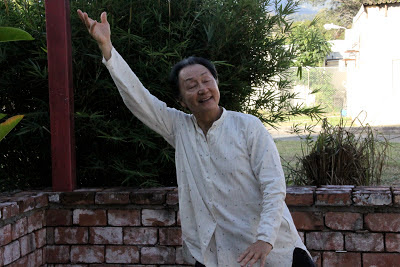 |
Chungliang Al Huang
|
"It's my life," professes Chungliang Al Huang, tai chi master, calligrapher, author. "I was groomed with tai chi, but one of my early loves was calligraphy."
Exuding an aura of an ascetic, artist, dancer, martial-arts trainer, Master Huang is merging tai chi with calligraphy. The beautiful confluence of the subtle meditative body movements combines with brush strokes in perfect harmony.
"We are lucky enough to use calligraphy as an art form. We dance on paper," Master Huang adds. "We literally immerse ourselves as a dancer through our brush, to be expressive."
Master Huang recounted that he started practising calligraphy as a child growing up in China and then in Taiwan. "As far back as I can remember, I loved to hold the brush, I loved the way the ink touched the paper."
DANCING MEDITATION
The flow of the liquid ink, he says, is a form of tai chi flow, which is dancing meditation.
 The calligraphy, Master Huang explains, is like stillness in motion. He describes calligraphy as the total immersion of the artist's spirit, personality. It's the artistic creative expression.
The calligraphy, Master Huang explains, is like stillness in motion. He describes calligraphy as the total immersion of the artist's spirit, personality. It's the artistic creative expression.
Illustrating the process as if drawing poetry in the air, he says: "Every Chinese brush would have flexible, resilient hair and you can create such a beautiful flow, and between every hair there is space, which creates this ying yang quality."
Calligraphy in China, he informs, existed even before paper was invented. "The characters were carved out on tortoise shells," he said. "Later, we invented the brush, which is a beautiful tool to give nuances.
"When brush and paper were invented, there were two media."
Even till this day in China, Master Huang informs, connoisseurs of art still value calligraphy higher than a painting.
Over the years, he says, this art form has gone through metamorphoses, keeping itself alive as traditions change and modern paradigms seep into the fabric of the Chinese society.
The Chinese language was simplified for it to be spread wide, and also to get the masses to be proficient.
But Master Huang emphasises that it is important to return to the traditions, as practicality sometimes overrides cultural and symbolic essence. "We need to return to the symbolism, to the metaphors, which is the essence of the Chinese language and the Chinese culture."
TAKING HEART OUT OF LOVE
 |
| Xin: Chinese symbol for heart |
The Chinese script, which is symbolic, has each character holding a deeper meaning to it. An example he cites is the symbol of 'love' in the traditional and simplified language.
"The Chinese symbol for love is a beautiful symbol," he says. "In the middle of love is the most important motif: the heart, xin. When the language was simplified and the strokes were taken out, they took the heart out of love ... can you imagine?
"How can there be no heart in love?"
Master Huang says that it is one of his life's goals to keep this art form alive, to help the people of the world recognise the deep-rooted and meaningful traditions of China that he grew up in.
The founder and president of Living Tao Foundation recalls, "In my era - I am 76 years old - in every traditional scholarly family, you let your offspring follow the tradition of the arts. You studied the classics, you recited the poetry and you did calligraphy. It is a part of your upbringing.
"It's so simple to put four strokes in. It is a beautiful symbol. Put the heart back into love, for you, your family, your children.
"It's easy; let's retrieve it and let's correct it," he says.
He says that he would like to spread goodness through his teachings and calligraphy to the world.
"I want the West to understand that it is an older culture, (which has) taken many thousands of years to evolve," he says. "You can have religious differences, you can have national differences, but we are all human beings."
Art and its nuances, according to Huang, who has been referred as 'a master in the arts of living', has the ability to transcend barriers, wherever and however they exist.
 |
| Flow of energy on ink...Master Huang signs a book |
"We are world citizens. We believe in good things, artistic things, beautiful things ... symbolism knows no language barrier," he says.
Master Huang, on his part, says he's striving to bring the citizens of this global village to bond in a common thread of love and humanity.
"I see myself as a philosopher, and as a person who builds bridges," he says, "I will, though, never consider myself as a master, because life is full of learning. If you stop learning, you stop living."
amitabh.sharma@hotmail.com
Published February 17, 2013 - The Sunday Gleaner

The calligraphy, Master Huang explains, is like stillness in motion. He describes calligraphy as the total immersion of the artist's spirit, personality. It's the artistic creative expression.











YES ! Thank you Chungliang for teaching me to dance : dance tai ji...dance caligraphy...dance my life. Duke
ReplyDeleteVery interesting. Teachers like him ensure the longevity of traditional culture and values across generations!
ReplyDeleteThis article captures Master Huang's spirit and joy of Tai Ji and Calligraphy! Wonderful!!
ReplyDelete